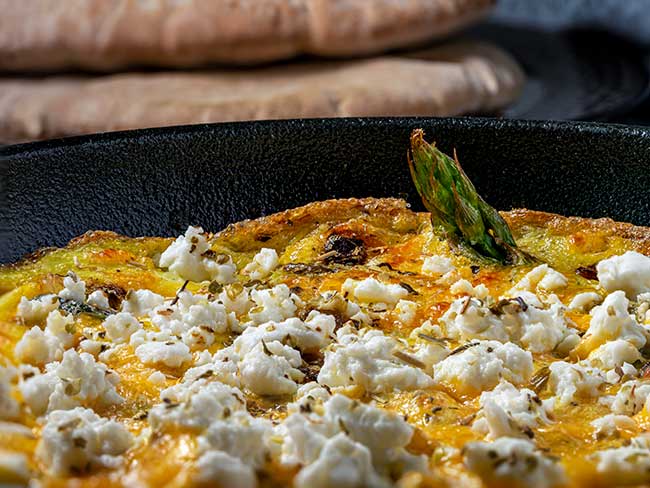Vegetables-of-Choice frittata
Only about 10% of Americans eat at least five servings of fruits and vegetables each day. Each serving is about 1/2 cup. Frittatas are a great way to get an extra serving for breakfast, lunch, or dinner.
I found some leeks and fresh asparagus at my hospital’s farmers’ market and, at the time, didn’t quite know what I was going to do with them. A frittata for a weekend breakfast turned out to be a good choice.
A friend of mine is an expert with frittatas. She has one of those two-sided non-stick frittata pans which I think is her favorite kitchen thing. She also suggests using a mix of whole eggs and egg whites — like 5 whole eggs and three whites for a four-serving frittata. That will keep the fat and cholesterol levels down a little without sacrificing flavor and texture.
Of course, the nutritional analysis can be controlled by what you add to the eggs. Many recipes call for a lot of cheese and say things like “Goats commonly graze on the steep coastal hillsides in Liguria.” You can use just a little cheese and still have great results.
I don’t have a frittata pan so I use a 12-inch oven-proof skillet for 4 eggs or a larger skillet for a four-serving frittata. After the eggs are initially set, I use the broiler for a few minutes.
Servings: 2
Ingredients
- 3 eggs and 1 egg white
- 12 spears of asparagus cut into 1-inch pieces, discarding the “woody” end
- 1 large leek, white and pale green part rinsed and sliced thinly
- 1 tablespoon extra virgin olive oil
- Cooking spray — I used olive oil
- 2 ounces feta
- 2 tablespoons chopped fresh parsley
- Salt and freshly ground pepper to taste
Directions
- Heat the oil in an oven-proof skillet. Sauté the asparagus and leeks until tender — about five minutes.
- Beat the eggs and egg white. Season the eggs with salt and pepper. Mix in most of the crumbled feta and the parsley. Preheat the broiler in your oven.
At this point, you could just add the egg mixture to the skillet and cook it but there’s always the risk it will stick. I moved the cooked veggies to 1/2 of the skillet and sprayed the empty half with a non-stick cooking spray then did the other half after moving the veggies around. This actually worked fine in the end. - Add the egg mixture and let it cook until it is mostly “set” but there are still some liquid eggs on top. Distribute the remaining feta.
- Broil it for a few minutes until it is slightly browned and fluffy. Remember to keep a hot pad on the skillet handle as a safety reminder for anyone who comes into the kitchen.
Nutrition information (per serving)
- Calories: 296
- Total fat: 20 g
- Saturated fat: 8 g
- Trans fat: 0 g
- Cholesterol: 458 mg
- Sodium: 458 mg
- Total carbohydrate: 12 g
- Dietary fiber: 3 g
- Protein: 18 g
